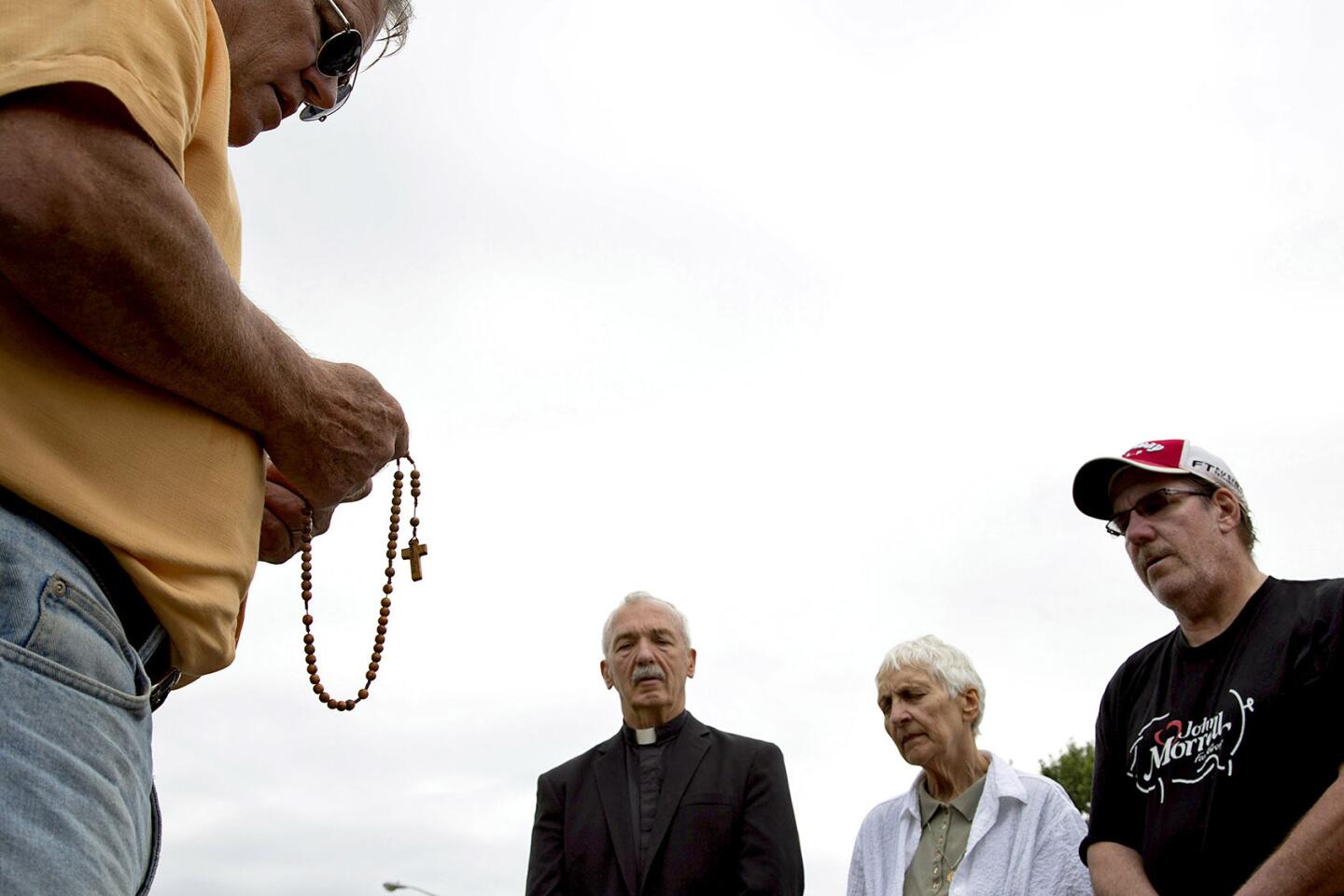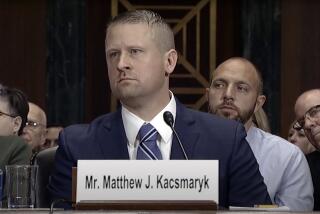The Abortion Wars: Doctor goes to great lengths to keep abortion accessible
Reporting from SIOUX FALLS, S.D. — Dr. Carol Ball was two-thirds of the way through her morning commute when she heard the news.
The first leg of her journey, a scooter ride to the Twin Cities airport, had been uneventful. Not so for the second leg — a 200-mile flight to Sioux Falls — as the U.S. Supreme Court struck down a Massachusetts law keeping protesters at least 35 feet from abortion clinics.
The loss of any kind of protection is a blow in Ball’s line of work, and the Massachusetts case had been widely watched. But the ruling will have no direct effect on the doctor in running shoes and khakis who performs abortions far from home.
Because losing protection means you have some to begin with.
“We don’t have a buffer zone,” Ball, 62, said, as she got off the plane. “We wanted one, talked for years about trying to get one.”
Several times every month, Ball jets into South Dakota to perform abortions at the only clinic in the Mt. Rushmore State — a Planned Parenthood facility that for the last decade has been unable to find a local doctor willing to perform the procedure.
During that time, South Dakota legislators passed some of the most restrictive laws in America governing women’s access to the procedure, including a 72-hour waiting period that does not count weekends or holidays.
The most controversial law, passed in 2011, requires every woman to visit what the state calls a “pregnancy help center” before having an abortion so she can hear about options available “to help her maintain her relationship with her unborn child.”
Planned Parenthood has sued state officials to stop the mandate; if the organization loses, the clinic’s future would be in question. Officials say the law is so offensive that closing the clinic is under discussion.
On this overcast Thursday in Sioux Falls, there were patients waiting, lots of them.
Ball heaved her backpack onto her shoulder and headed off to the airport escalators to meet the security guard with the sturdy SUV whose job it is to make sure she gets safely to her destination.
Through Sioux Falls Regional Airport. Past neat houses with pickups parked out front. In and out of a Subway for a sandwich to be eaten on the run. Around a smattering of protesters at Planned Parenthood’s driveway. Into the secure clinic on the edge of town.
::
Ball rushed into the spare facility through a back door guarded by security cameras. The waiting room sports a soda machine and an aging television. A “bomb threat/robbery checklist” hangs by the phone in the central lab, where Ball goes over charts. She donned her blue scrubs, bolted down her chicken sandwich and prepared to see her first patient.
It was Ball’s second trip to South Dakota this week and the second time each of her 17 abortion patients had visited the clinic. A woman seeking an abortion in South Dakota must have an “initial consultation” and return 72 hours later for the procedure.
On Monday, Ball met with every woman scheduled to have an abortion. Because the clinic is the only one in the vast, rural state, many patients drive four or five hours each way. They arrive on Mondays, go home, and return again on Thursdays — upward of 20 hours on the road for a procedure that takes minutes.
Ball is loath to talk about what goes on between physician and patient during the mandated first visit. The clinic has been embroiled in litigation for more than a decade. As medical director for Planned Parenthood of Minnesota, North Dakota, South Dakota — and lead plaintiff in the current suit — she fears that anything she says could be used against Planned Parenthood in court.
But state law is clear about what Ball is required to discuss with her patients. First she has to make sure that they were not coerced into ending their pregnancies. That’s no problem, she said, because she would do that anyway.
It’s the other requirements that cause her to squirm — the ones that mandate her to pass on information that she believes medical research has called into question or outright debunked but legislators have placed into law.
Ball is required to tell her patients that the abortion could cause an increased risk of depression or suicidal thoughts. She also is required to tell them that, according to state law, the abortion “will terminate the life of a whole, separate, unique, living human being,” even if they are only a few weeks pregnant.
In 2005, the South Dakota Legislature convened a four-day hearing to study abortion, its effect on women and the science of reproduction. It was the beginning of an effort here to dismantle Roe vs. Wade, the 1973 Supreme Court decision that legalized abortion.
The desire, officials said in a report released after the hearing, is to protect women who had been “misled” from undergoing a procedure they did not understand. One expert quoted in the report told the legislative task force that women’s “abortion-related reasoning” is “significantly lower than their general reasoning abilities.”
“However, after the stressfulness of the decision and the procedure have ended,” the report said, “women’s cognitive abilities return to normal, often ushering in feelings of pronounced guilt, sadness and regret.”
Ball has performed abortions for more than 30 years. She knows every woman responds differently, that what brings deep relief to some creates regret and conflict for others.
But she considers the legislative reasoning here “pseudo-science of the anti-choice people.” Abortion, she said, terse and wary, “is basic healthcare for women. One in three women have an abortion in their lifetime. How much more basic is that?”
::
Elizabeth, who would give only her middle name to protect her privacy, was about three weeks pregnant, and clinic staff members said she traveled farther than any other patient who has come to the Sioux Falls clinic for an abortion.
She, her fiance and their two Labrador retrievers live in a small recreational vehicle in Watford City, N.D., 550 miles away. They moved there recently from Sioux Falls. She quit her job at a casino and has yet to find work in North Dakota.
On Sunday at 9 a.m., Elizabeth piled into her SUV with a couple of cans of AMP Energy drink to keep her alert, a stack of CDs and a Lab for company. Nine and a half hours later, she arrived in Sioux Falls.
She still has a house here, so she can afford to stay in town during the waiting period between consultation and abortion. Elizabeth said gas would cost about $140 each way.
The waiting period, she said, was the most wrenching part of the entire process.
“It’s hard enough to make the decision to come here once, but to have to come back here three days later? I don’t know; it’s difficult,” she said. “But I made the decision. It’s not the time. We live in an RV. I don’t have a job. I’m 36. And I smoke.”
Elizabeth said the Monday consultation with Ball was “very detailed and thorough. They make sure you understand what you’re doing and that this is your decision.... It’s very comforting.”
Ball is one of six physicians who fly in to do both surgical and medical procedures here for patients who, under state law, cannot be more than 13 weeks and six days pregnant. During a surgical abortion, which takes about 10 minutes, the patient is given a local anesthetic before the uterus is suctioned out. This method is used for women who are between six and 14 weeks pregnant.
Elizabeth was having a medical abortion, which is an option for women who are up to 10 weeks pregnant. Medical abortions, which are a two-part procedure, can be done earlier in a pregnancy. Anesthesia is not required.
On Thursday, she checked in early for an 11:45 a.m. appointment. First, Ball gave Elizabeth a drug to take called mifepristone; it blocks the growth of the placenta. Then the physician sent her home with a drug called misoprostol, which makes the uterus contract and causes it to empty. It must be taken 24 to 48 hours after the first drug.
As she waited for a friend to pick her up, Elizabeth leaned against the clinic wall, clutching a small brown paper bag that held the second drug. Her eyes were obscured by big, dark glasses. Smoke curled up and away from her cigarette.
::
Ball entered Mayo Medical School in 1973, the year Roe vs. Wade was decided. In the early 1980s, she learned that a women’s health clinic had opened in Duluth, Minn., founded in part by Dr. Jane Hodgson, the first doctor in the U.S. convicted of performing an abortion in a hospital.
“And so I decided, I’m a good feminist, I’ll learn how to do abortions,” recalled the obstetrician-gynecologist. “I went over there and learned how to do abortions from Jane Hodgson.... There were usually protests. And there are still protesters.”
Ball splits her time among the Duluth clinic, Planned Parenthood’s St. Paul headquarters and the Sioux Falls clinic. Of the three facilities, the St. Paul center draws the most demonstrations.
It is quieter in Sioux Falls, perhaps because antiabortion laws are stronger here. Still, total prohibitions have not succeeded. Then-Gov. Mike Rounds signed a 2006 law banning the procedure. It was later overturned by voters. Another outright ban was defeated at the ballot box in 2008.
On this Thursday at the end of June, Sara Beaner and five of her children held up a homemade sign to passing traffic on the outskirts of Sioux Falls. Son Joseph, 18, and daughter, Sister Mary Elizabeth of the Incarnation, 23, were absent from the family protest.
“I am here to let everybody know that they are wonderfully made in God’s eyes and that they should have a chance in life,” Beaner said. “We hope to close the place down.”
The Beaners were gone by the time Ball packed up and left the clinic for her evening flight. “Beat” was how she described herself, after performing five medical abortions, 12 surgical abortions and two examinations of women whose Pap smears were abnormal.
In the SUV with the security guard at the wheel, she was quiet and pensive. She does this work, she said, “because I think it’s important for women to have access to abortion care.”
But the Supreme Court decision striking down the Massachusetts buffer zone weighed heavily. It is an illustration, she said, of a Supreme Court that is hostile to the work she does and the rights of the women for whom she cares.
The SUV neared the airport. Ball gathered her belongings.
“I’m feeling very discouraged,” she said.
Still, she will return.
@marialaganga
More to Read
Sign up for Essential California
The most important California stories and recommendations in your inbox every morning.
You may occasionally receive promotional content from the Los Angeles Times.



















